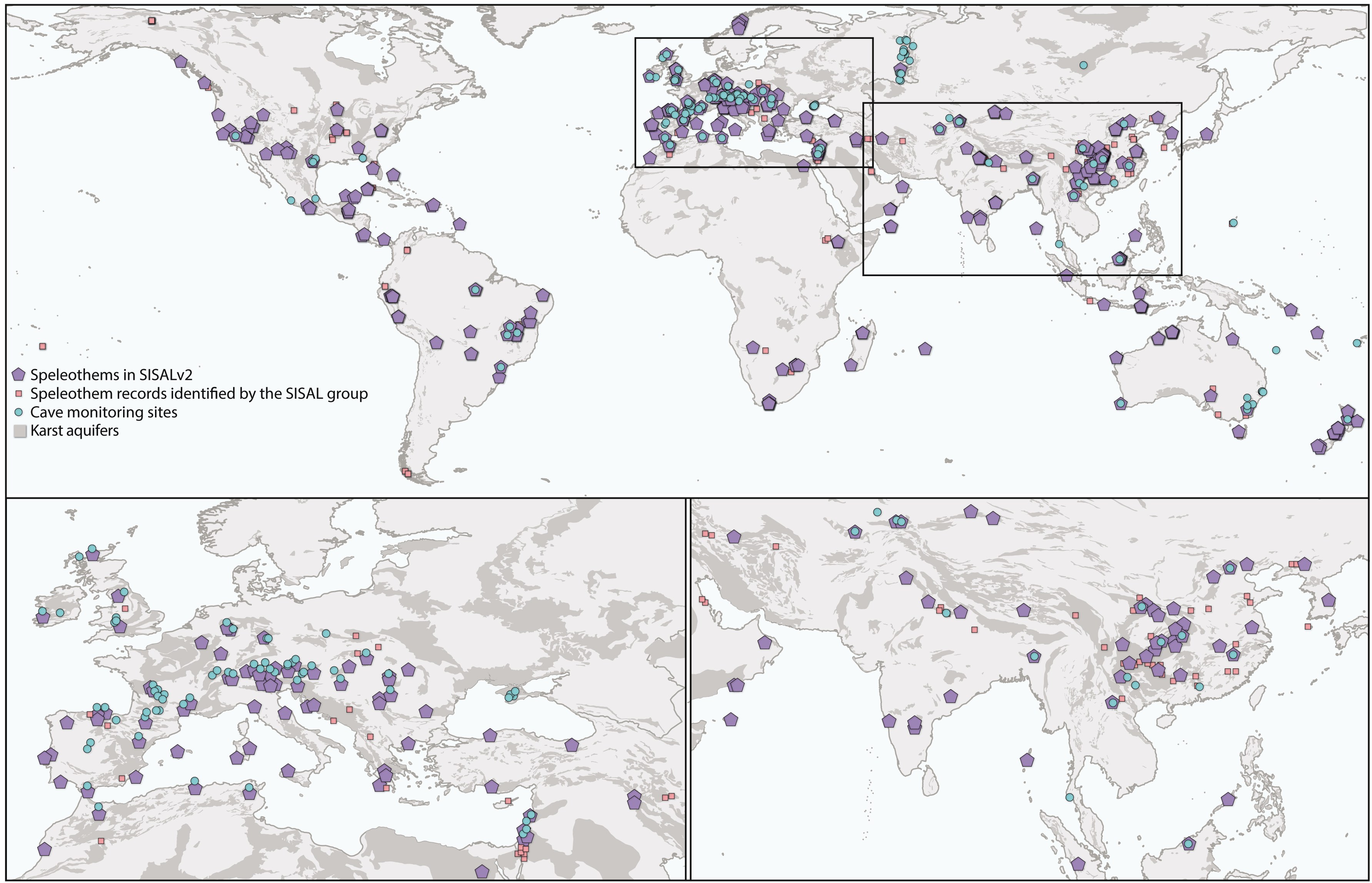- Home
- Publications
- PAGES Magazine
- SISAL Achievements and Future Initiatives
SISAL achievements and future initiatives
Kaushal N, Lechleitner F & Comas-Bru L
Past Global Changes Magazine
28(2)
60
2020
Nikita Kaushal1, F. Lechleitner2 and L. Comas-Bru3
Phase 1: Achievements
Speleothems are important paleoclimate archives because of their global distribution and exceptional age control. During Phase 1 (2017–2020), the PAGES working group Speleothem Isotopes Synthesis and Analysis (SISAL; pastglobalchanges.org/sisal) built a global network of speleothem researchers and created a global database of speleothem oxygen and carbon isotopes. Led mainly by early-career researchers, the group has published three database versions (SISAL_v1: Atsawawaranunt et al. 2018a, 2018b; SISAL_v1b: Atsawawaranunt et al. 2019; Comas-Bru et al. 2019; SISAL_v2: Comas-Bru et al. 2020a, 2020b). SISAL_v2 contains nearly 700 speleothem records with standardized age models and incorporates most of the speleothem records published so far (see Fig. 1).
The first version was supported by a paper summarizing our experiences with building SISAL_v1 (Comas-Bru and Harrison 2019), and a special issue comprising regional reviews of speleothem-based climate reconstructions (pastglobalchanges.org/products/12764). SISAL also published a protocol to use the database for isotope-enabled model evaluation (Comas-Bru et al. 2019). Since then, the database has been used to address long-standing fundamental issues, such as the relationship between the oxygen isotopic composition of speleothems, drip water, and meteoric precipitation (Baker et al. 2019); data-model comparisons examining the impact of convective activity on precipitation oxygen isotopes (Hu et al. 2018); data-model comparisons on interpreting oxygen isotopes from monsoon regions on orbital time-scales (Parker et al. 2020); and model reconstruction of the mid-Holocene to examine insolation forcing of climate (Cauquoin et al. 2019). An additional paper used the SISAL database to look at routinely measured and rarely interpreted speleothem carbon isotopes (Fohlmeister et al. 2020).
Long-term data stewardship
In the last three years, SISAL has fostered community discussions on data quality and sharing, and provided proof of aligned academic incentives resulting from such activities. This has been achieved through a team of regional coordinators supported by the group's Steering Group. During Phase 2, we are exploring the next step of providing long-term data stewardship in larger community-curated database sites. This will ensure that quality-checked, up-to-date speleothem data will be available beyond the working group's timeline. Further, this will ensure that public archiving of speleothem data is supported by a community that is actively engaging with issues such as data standardization and interoperability.
Phase 2: Future initiatives
During Phase 1, we created a database of speleothem isotopic data, the most commonly measured speleothem proxy. However, many factors influence the isotopic composition of speleothems and robust interpretations remain a key gap. During Phase 2, we will use (1) cave monitoring data and process-based models to establish more robust baselines for the modern period, and (2) contiguous speleothem measurements, such as trace element records, to facilitate interpretations of the recorded regional climate and environmental changes.
We are liaising with the cave monitoring community via the Innsbruck Quaternary Research group (cave-monitoring.org) to gather data from individual researchers. Currently, the webpage consists of cave locations, lists of measured cave monitoring parameters, and contact information (Fig. 1). Phase 2 aims to build a database of cave-monitoring data as required for proxy-system and process-based modeling. We will also examine over 50 recent publications on the application of trace element proxies from speleothems, to understand how trace elements can strengthen climatic interpretations of speleothem isotopic data in addition to providing independent paleoclimatic and paleoenvironmental information. These two research avenues should ultimately provide us with a new set of tools for robust interpretations of the speleothem records for use in PMIP isotope- and non-isotope enabled climate model evaluations.
As we begin our work on Phase 2, we encourage interested researchers from all career stages and backgrounds to join the group. Contact a member of the Steering Group (pastglobalchanges.org/science/wg/sisal/people), subscribe to the SISAL mailing list (listserv.unibe.ch/mailman/listinfo/sisal.pages), or follow us on Twitter (@SISAL_wg).
affiliationS
1Asian School of the Environment, Nanyang Technological University, Singapore
2Department of Chemistry and Biochemistry, University of Bern, Switzerland
3School of Archaeology, Geography and Environmental Science, University of Reading, UK
contact
Nikita Kaushal: nikitageologist gmail.com
gmail.com
references
Atsawawaranunt K et al. (2018a) SISAL database Version 1.0. University of Reading. Dataset
Atsawawaranunt K et al. (2018b) Earth Syst Sci Data 10: 1687-1713
Atsawawaranunt K et al. (2019) SISAL database Version 1b. University of Reading. Dataset
Baker A et al. (2019) Nat Commun 10: 1-7
Cauquoin A et al. (2019) Clim Past 15: 1913-1937
Comas-Bru L, Harrison SP (2019) Quaternary 2: 7
Comas-Bru L et al. (2019) Clim Past 15: 1557-1579
Comas-Bru L et al. (2020a) SISAL database Version 2.0. University of Reading. Dataset
Comas-Bru L et al. (2020b) Earth Syst Sci Data 12: 2579-2606
Fohlmeister et al. (2020) Geochim Cosmochim Acta 279: 67-87
Hu J et al. (2018) J Geophys Res: Atm 123: 13,595-13,610
Parker SE et al. (2020) Clim Past Discuss, doi:10.5194/cp-2020-78

